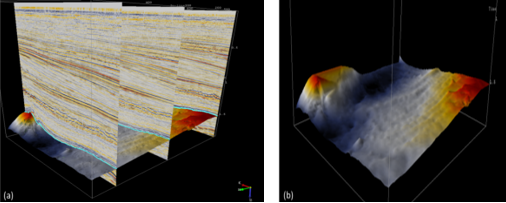Automated Seismic Horizon Tracking Using Advance Spectral Decomposition Method
Keywords:
Horizon Surface, Spectral Decomposition, Fault Displacement, Cosemblance, Seismic.Abstract
Introduction/Importance of Study: In three-dimensional seismic interpretation, automatic horizon tracking is a critical productivity tool. However, it often fails in areas where horizons are not smooth and exhibit sharp discontinuities such as large spatial displacement or changes in reflector aliasing, horizon gradients, and signal character. Such failures require manual intervention, which increases the interpretation cycle time.
Novelty Statement: In this research study, an automated horizon tracker is proposed that adapts to changes in reflector shape, strength, and geological variation as it traverses through the seismic data volume.
Material and Method: A predefined spatial grid window steers across the horizon surface where its orientation changes with the variation in a pre-computed, high-resolution, dip volume. The method is further improved to incorporate tracking horizons across discontinuities i.e. faults.
Result and Discussion: The proposed method is tested on three-dimensional seismic data with varying geological conditions and has demonstrated successful mapping of horizon surfaces and effective matching across major faults.
Concluding Remarks: Our automatic procedure, by reducing the need for manual intervention during interpretation, has the potential to significantly improve productivity.
References
C. Luo, “Horizon tracking in seismic data using machine learning and deep neural networks,” Appl. Geophys., vol. 16, no. 2, pp. 183–193.
M. A. Mirza, “Automatic seismic horizon tracking with wavelet transform and machine learning,” J. Pet. Sci. Eng., vol. 189, 10704, 2020.
M. S. Ghaderi, “Automated horizon tracking using wavelet coherence and dynamic programming,” Geophysics, vol. 83, no. 5, pp. D281–D292, 2018.
X. Luo, “Efficient horizon tracking by dynamic programming and machine learning,” Geophys. J. Int., vol. 217, no. 3, pp. 1813–1826, 2019.
Z. Wang, “Multi-attribute horizon tracking using convolutional neural networks,” Geophys. J. Int., vol. 221, no. 3, pp. 1853–1870, 2020.
H. Zhang, “Horizon tracking with deep learning and seismic attribute analysis,” J. Appl. Geophys., vol. 174 103975, 2020.
F. Chen, “Horizon tracking in seismic data using a novel constrained local tensor voting algorithm,” J. Appl. Geophys., vol. 144, pp. 142–153, 2017.
J. Liu, “Horizon tracking and interpretation with machine learning and signal processing,” J. Appl. Geophys., vol. 185, 10428, 2021.
S. Hosseini, “Seismic horizon tracking using a hybrid optimization approach combining graph cuts and particle swarm optimization,” J. Appl. Geophys., vol. 154, pp. 159–170, 2018.
K. Y. Huang, “Hopfield neural network for seismic horizon tracking,” X Annu. Int. Meet. SEG, Expand. Abstr., 1990.
P. Alberts, M. Warner, and D. Lister, “Artificial neural networks for simultaneous multi horizon tracking across discontinuities,” SEG Tech. Progr. Expand. Abstr., vol. 19, no. 1, pp. 651–653, Jan. 2000, doi: 10.1190/1.1816150.
M. Aurnhammer, “Model-based image analysis for automated horizon correlation across faults in seismic data,” PhD Thesis, Univ. Magdebg., 2003.
M. Aurnhammer and R. Mayoral, “Improving seismic horizon matching by ordinal measures,” Proc. - Int. Conf. Pattern Recognit., vol. 3, pp. 642–645, 2004, doi: 10.1109/ICPR.2004.1334611.
F. Admasu and K. Toennies, “Automatic method for correlating horizons across faults in 3D seismic data,” Proc. IEEE Comput. Soc. Conf. Comput. Vis. Pattern Recognit., vol. 1, 2004, doi: 10.1109/CVPR.2004.1315021.
P. Verney, J. F. Rainaud, M. Perrin, and M. Thonnat, “A knowledge-based approach of seismic interpretation: Horizon and dip-fault detection by means of cognitive vision,” SEG Tech. Progr. Expand. Abstr., vol. 27, no. 1, pp. 874–878, Jan. 2008, doi: 10.1190/1.3063780.
M. Su, F. Qian, S. Cui, C. Yuan, and X. Cui, “Research on a 3D Seismic Horizon Automatic-Tracking Method Based on Corrugated Global Diffusion,” Appl. Sci. 2023, Vol. 13, Page 6155, vol. 13, no. 10, p. 6155, May 2023, doi: 10.3390/APP13106155.
A. Abubakar, H. Di, Z. Li, H. Maniar, and T. Zhao, “An artificial intelligence workflow for horizon volume generation from 3D seismic data,” Lead. Edge, vol. 43, no. 4, pp. 235–243, Apr. 2024, doi: 10.1190/TLE43040235.1.
C. D. S. Alves, B. S. Silva, C. H. S. Barbosa, F. A. Rochinha, A. L. G. A. Coutinho, and D. M. S. Filho, “Horizon extraction using absolute seismic phase obtained by unwrapping techniques,” J. Appl. Geophys., vol. 218, p. 105198, Nov. 2023, doi: 10.1016/J.JAPPGEO.2023.105198.
Z. Y. Y. M. Qiong, X. HuiQun, P. Zhen, W. ZheFeng, “Application of regression method based on knowledge distillation in seismic horizon tracking,” Prog. Geophys., vol. 38, no. 3, pp. 1217–1227, 2023.
Y. He, Y. Chen, F. Qian, X. He, B. Zheng, and G. Hu, “Multiple Attribute Regression Network for 3-D Seismic Horizon Tracking,” IEEE Geosci. Remote Sens. Lett., vol. 20, 2023, doi: 10.1109/LGRS.2023.3324746.
M. M. Khan and A. Alam, “Co-Semblance Horizon Tracking across Large Faults,” Glob. Meet. Abstr., pp. 1–4, Sep. 2012, doi: 10.1190/IST092012-001.99.
“TerraNubis - Data Info of F3 Demo 2020.” Accessed: Jun. 03, 2024. [Online]. Available: https://terranubis.com/datainfo/F3-Demo-2020
“TerraNubis - Data Info of Penobscot.” Accessed: Jun. 03, 2024. [Online]. Available: https://terranubis.com/datainfo/Penobscot
“Open Seismic Repository 2020c, Teapot Dome, Data set accessed January,” 2020, [Online]. Available: https://wiki.seg.org/wiki/Teapot_dome_3D_survey
P. Kumar and E. Foufola-Georgiou, “Time-space varying spectra for seismic processing,” Wavelets Geophys., pp. 1–43, May 2008.

Downloads
Published
How to Cite
Issue
Section
License
Copyright (c) 2024 50SEA

This work is licensed under a Creative Commons Attribution 4.0 International License.




















